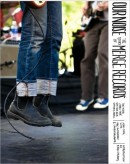Every Thursday on the blog brings a post about a paperback book.
 The North Carolina-based Merge Records is an independent label that is thriving while larger conglomerates try (and mostly fail) to play catch-up with the 21st century. Merge began 20 years ago as a way for Mac McCaughan and Laura Ballance to release records by their band, the seminal Superchunk, and the bands of their friends in the Chapel Hill scene. In Our Noise: The Story of Merge Records
The North Carolina-based Merge Records is an independent label that is thriving while larger conglomerates try (and mostly fail) to play catch-up with the 21st century. Merge began 20 years ago as a way for Mac McCaughan and Laura Ballance to release records by their band, the seminal Superchunk, and the bands of their friends in the Chapel Hill scene. In Our Noise: The Story of Merge Records, they’ve teamed up with journalist John Cook to produce an addictive oral history of the enterprise. Reading the oversized paperback, generously stuffed with reminiscences and personal photos from artists, will be an intense nostalgia trip for anyone who came of musical age in the early 1990s.
With bands like Arcade Fire and Spoon currently in its stable, Merge is probably doing better business than ever in 2009, but the majority of the book covers its first decade, when it moved from a bedroom hobby to one of the most respected, influential labels in the country. In the introduction to the first chapter, we’re told that the Chapel Hillers learned lessons from Corrosion of Conformity, a 1980s band based in neighboring Raleigh that “didn’t believe in waiting around for someone with money to tell them that it was okay for them to make records” and knew that “making noise wasn’t rocket science.”
Chapters covering Superchunk and the broader history of Merge alternate with chapters that serve as mini-histories of bands like The Magnetic Fields, Lambchop, Spoon and Neutral Milk Hotel. The latter is maybe most compelling, because after touring to support the Anne Frank-inspired cultic masterpiece, In the Aeroplane Over the Sea, the band’s leader, Jeff Mangum, essentially disappeared from the music world, even declining an invitation to open for R.E.M. He became — and remains — “the J. D. Salinger of indie rock.”
Mangum declined to be interviewed for the book (like any good Salinger would, though he did send along a brief note of praise for Merge), but the chapter on his band offers a shaggy portrait of their “Bad News Bear quality” that helps to dispel any mythic aura. As fellow Merger Matt Suggs said: “Most bands who tour have a method of loading the van where everything just kind of fits. And with them, it always looked like a three-year-old had packed the f***ing thing. They’d open the door and here would come a cymbal rolling out, and they’d go chasing it.”
The real charm of the collection is in its more candid moments, which read like a yearbook made by a committee of just the smart, cool kids. One photo caption reads, “Mac’s parents’ van after catching fire in New Mexico in 1989.” One interviewee admits, “This is going to sound really stupid, and I know I sound stupid saying it. But I was the king of the scene at the time.” McCaughan and Ballance openly discuss their 1994 romantic breakup, which didn’t (permanently, anyway) splinter the band. (A mutual friend: “Laura broke up with Mac because he was a jerk.” Mac: “I take umbrage at that description of me.”)
Recounted elsewhere are the difficulties of driving across a road covered in rabbits, the help of parents in naming bands, Sammy Hagar’s surprisingly durable wisdom about the creative process and Ballance’s account of how Merge came to be Merge:
The label was totally Mac’s idea. To call it “Merge” was my idea. We were driving through Colorado, and I started reading road signs while I was thinking about a name for it. I actually thought it was a pretty dumb name for a long time. But it’s certainly better than “Pronghorn Antelope,” which is another thing I saw while I was driving on that trip.

